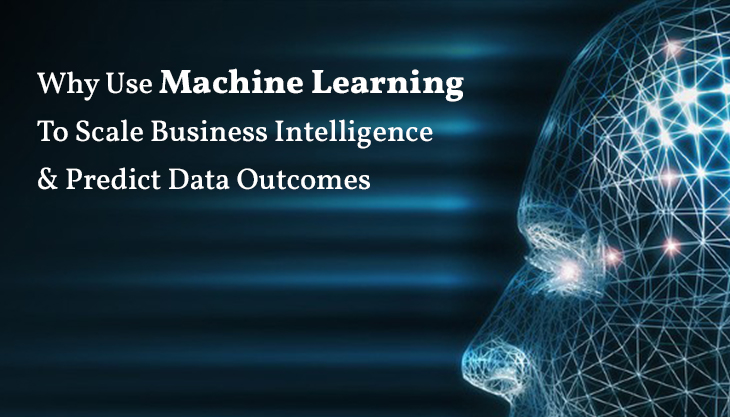We all want to work effectively in today's culture because we want to conserve energy while accomplishing many tasks. It is hardly surprising that people have developed tools and other equipment to accomplish this.
Additionally, the fact that everyone reading this post is doing it on a computer or a smartphone is evidence of how quickly technology has changed our lives. In this scenario, AI services are useful.
Machine intelligence is evolving into a tool to help people with daily chores, from regular work to extremely precise tasks. In general, these machines are much faster, more accurate, and better at their jobs than humans.
In this post, we'll demonstrate how to maximise the value of your data and use machine learning to enhance your current business intelligence (BI) skills. Various machine learning applications and AI services, such as natural language processing, financial risk assessment, consumer segmentation, and others, will also be presented.
How Can Data Be Used to Create Judgments Based on Facts?
Have you ever thought about how business intelligence might affect the way we run our operations? The cold numbers are what matter at the end of the day. You might be able to paint a more nuanced and polished image of the performance of your business with correct and current data. Businesses that are able to quickly adjust to environmental changes are able to produce more outstanding value.
Never forget that data is only meaningful when used in concert with other tools. Businesses can more effectively determine which patterns are more significant and how to make weighted judgments when they utilise machine learning to extract insights from data. We'll examine how business intelligence and machine learning can give companies a competitive edge in the paragraphs that follow.
You Can Utilise Machine Learning to Enhance Your Present BI Skills
There is a growing understanding that BI and machine learning are both facilitators of one another and work best when used together for enormous volumes of data being used for business objectives.
A technique for finding abnormalities in business intelligence operations is machine learning. Machine Learning can help you to Scale Predict Data Outcomes and comprehend how to grow operations to satisfy customer needs based on market demand, leading to a wide range of profitable possibilities.
Businesses may now create descriptive visions thanks to business intelligence (BI), which has evolved from static reports to interactive dashboards and real-time analytics.
The three machine learning methods that are most frequently employed are classification, regression, and clustering.
Classification
A stunning application of machine learning is classification. It is a technique for grouping data into segments based on predetermined labels.
Regression
Regression is a technique for determining how dependent and independent variables are related.
Clustering
An unsupervised machine learning process called clustering divides objects into groups based on their similarities. It is applicable to unlabeled data.
Why Is Machine Learning a Must for Business Intelligence?
Do you know what advantages computer programming has? Utilising machine learning has three main benefits.
When people are too lethargic to perform things, machine learning can accomplish a lot and make tasks simple to execute. Many excellent images and speech recognition have been produced after numerous training cycles; these are some examples of machine learning.
Use Machine Learning to Scale Business Intelligence
Algorithms for machine learning are flexible and responsive to input data. A machine learning system for interpreting handwritten text that is adept at adapting to various handwriting styles is a well-known example.
6 Uses for Machine Learning
1. Processing of Natural Language
One of the most popular machine learning applications is this one. Combining artificial intelligence, machine learning, and linguistics may enable machine-human communication.
Use natural language processing to enhance the personalised and informative nature of BI (NLP). And this is one of the most intriguing uses of machine learning.
Since NLP makes data management easier, you can get responses and accurate measurements at any time and from any place. This increases the usability of the data. Because the processing is done in the cloud, complex data mining and software expertise are not required.
2. Your existing business intelligence capabilities can be supplemented with predictive analytics.
Business intelligence uses a variety of analytics techniques to turn raw data into knowledge that is both useful and relevant. Its technologies can extract relevant data, increase its dependability, accuracy, and user attractiveness.
3. Application of machine learning in customer segmentation
As each consumer has different tastes, expectations, demographics, hobbies, and habits, it will never be easy to understand and meet their demands. Due to these difficulties, customer and market segmentation—the division of consumers and markets into smaller groups that share market characteristics or behaviours—was created.
Customer segmentation will always need a considerable amount of manual labour and be a time-consuming process. Machine learning is also effective at grouping consumer segments with similar market characteristics.
4. Financial modelling and risk assessment
Applications for business intelligence in finance are numerous. In addition to being used to estimate financial performance, predictive analytics models have also been demonstrated to evaluate investment project risk and create financial products like derivatives for the companies who use machine learning.
Risk analysis will surely help those decision-makers gauge the potential impact of the many choices they constantly make and assess the value of a prospective reward. This is particularly true when the current circumstance involves an uncertain and dangerous pattern of upcoming occurrences anticipated in the financial sphere.
5. Sales forecasting, market research, and churn prevention
When using business intelligence models enhanced by machine learning, marketing is always in the lead. Advertising budget, product line management, demand forecasting, more effective pricing strategies, and increased customer loyalty can all benefit from marketing analytics.
Using sales history and market survey data, businesses may produce precise sales forecasts and strategies that improve profit, customer experiences, and expectations while lowering attrition rates.
6. The use of healthcare data in machine learning
Machine learning processing in healthcare is expanding as a result of the ongoing push to reduce costs and offer better treatments. These unstructured data can be found and gathered by machine learning algorithms to extract insights.
One goal that can be accomplished by analysing electronic health data using deep learning and natural language processing is the prediction of patient outcomes.
Using Data-Driven Methods to Increase Company Agility, Business Intelligence and Machine Learning Are Combined
Business intelligence aims to help people make wiser decisions. We think that all of the machine learning techniques we've discussed in this post will help all decision-makers to analyse data more effectively, forecast the future, and assess potential solutions.
In terms of functionality and the supply of data, machine learning and business intelligence are comparable, but when companies use machine learning effectively, it has a lot of potential. Their output is more accurate and uncovers hidden patterns and insights in the data as more inputs are received.
We have long held the opinion that business intelligence and machine learning should be combined to provide a competitive advantage.

















Post Comments